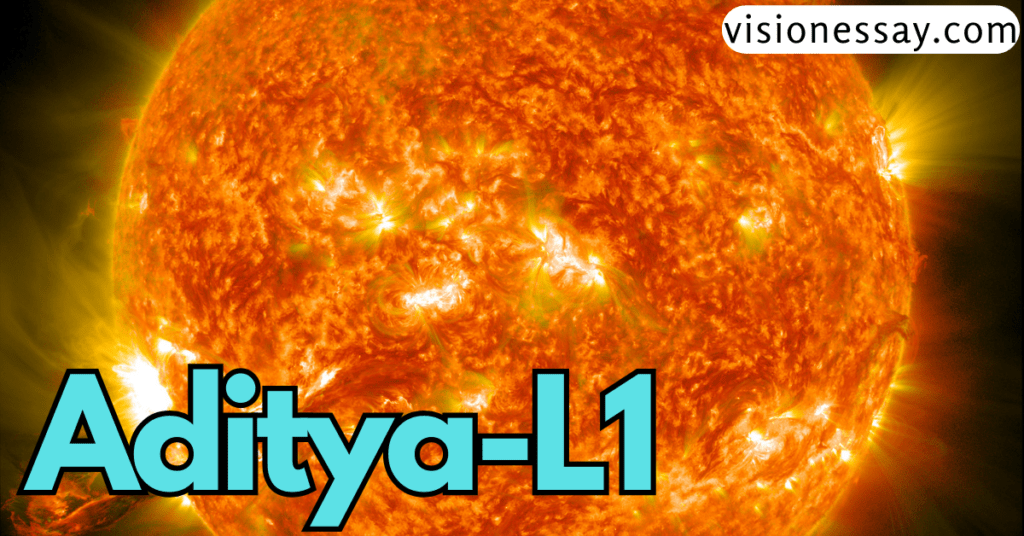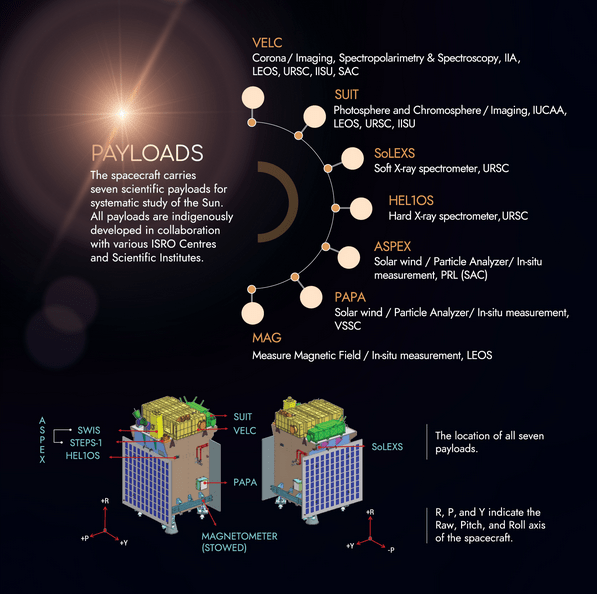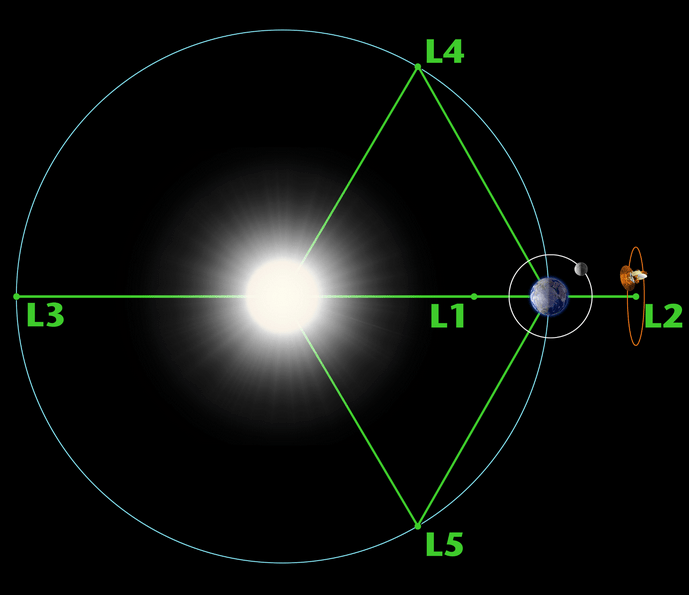
Introduction
The first Solar Mission, Aditya-L1, was successfully launched by the Indian Space Research Organization (ISRO) recently.PSLV-C57 rocket was used for the launch. A first in ISRO’s history, the fourth stage of the PSLV was fired twice to perfectly place the spacecraft into its elliptical orbit.
What is Aditya-L1 Mission?
- Aditya-L1 is the first Indian solar mission of its kind to investigate the Sun from a significant distance of 1.5 million kilometers in orbit.
- To get to the L1 point, it will take about 125 days. After AstroSat (2015), Aditya-L1 is ISRO’s second astronomical observatory-class project.
- The project’s route is noticeably shorter than that of Mangalyaan, India’s previous Mars orbiter mission.
- A halo orbit will be created for the spacecraft around the Sun-Earth system’s Lagrangian point 1 (L1).
What is Objective of Aditya-L1 Mission?
- The mission seeks to offer an important new understanding of the solar corona, photosphere, chromosphere, and solar wind.
- Aditya-L1’s main goal is to learn more about the behavior of the Sun, including its radiation, heat, particle movement, and magnetic fields, as well as how they affect Earth.
What are Payloads in Aditya-L1 Mission?
Seven different equipment will be on board Aditya L1 to examine the Sun.
- Visible Emission Line Coronagraph (VELC): This device will capture visible light images of the solar corona.
- Solar Ultraviolet Imaging Telescope (SUIT): This device will capture an ultraviolet picture of the solar atmosphere.
- Solar Low Energy X-ray Spectrometer (SoLEXS): This device will analyze the solar corona’s X-ray spectrum.
- High Energy L1 Orbiting X-ray Spectrometer (HEL1OS): The solar corona’s high-energy X-ray spectrum will be measured using this device.
- Solar Wind Composition Spectrometer (SWCS): This device will analyze the solar wind’s composition.
- In-situ Magnetometer (ISM): The magnetic field present in the solar wind will be measured using this device.
- Electron Detector (ED): The solar wind’s electron density will be measured using this device.

What are Lagrange Points?
- Lagrange points are unique locations in space where the gravitational pull of two massive orbiting planets, like the Sun and the Earth, is balanced.
- This implies that a little object, like a spaceship, may stay at these locations without burning through a lot of fuel to keep its orbit stable.
- Each of the five Lagrange Points has unique properties. These points allow for the steady orbital motion of a tiny mass between two bigger masses.
Also Read: Chandrayaan 3: A Way To Moon
What are Lagrange Points in the Sun-Earth System?
- L1: The Lagrange point L1 is thought to be the most important for solar observations. The main benefit of having a satellite in the halo orbit around the L1 is that it can continually see the Sun without being blocked by clouds or experiencing eclipses. The Solar and Heliospheric Observatory Satellite (SOHO) is currently residing there.
- L2: L2, which is immediately ‘behind’ Earth as viewed from the Sun, is a great place to observe the greater Universe without being distracted by Earth’s shadow. Near L2, the Sun is orbited by the James Webb Space Telescope.
- L3: It gives the possibility of viewing the far side of the Sun because of its location behind the Sun, across from Earth, and just outside of Earth’s orbit.
- L4 and L5: The two bigger entities create an equilateral triangle with the objects at L4 and L5, which remain in their stable places. They are often employed by space observatories, like those used to examine asteroids.

What is the Significance of Exploring the Sun?
- Understanding Our Solar System: The Sun is at the core of our solar system, and as such, all other celestial bodies are highly influenced by the Sun’s features. Our knowledge of the dynamics of our solar neighborhood is improved through research on the Sun.
- Space Weather Prediction: The space environment around Earth can be affected by solar activity such as solar flares and coronal mass ejections. Foreseeing and preventing probable outages of communication networks, navigational systems, and power grids, it is essential to comprehend these occurrences.
- Advancing Solar Physics: Fundamental physics and astrophysics are improving as a result of research into the complicated behavior of the Sun, including its magnetic fields, heating processes, and plasma dynamics.
- Enhancing Energy Research: The Sun is an organic fusion power plant. We may pursue clean and sustainable fusion energy on Earth using the knowledge we obtain from understanding its core and nuclear processes.
- Improving Satellite Operations: Satellites and spacecraft are impacted by solar radiation and solar wind. Better spacecraft design and operation are made possible by understanding these solar interactions.
Conclusion
Aditya L1 mission, which will reveal fresh perspectives on the Sun and its impact on the Earth. Its broad range of goals centers on investigating many facets of the Sun’s outermost atmosphere, its impact on space weather, and the fundamental physics mechanisms behind these phenomena. This information has practical ramifications for technology and systems on Earth in addition to improving our understanding of the Sun itself.
Frequently Asked Questions(FAQs)
Who designed Aditya-L1 mission?
The Indian Space Research Organization (ISRO) and many national research institutions, notably the Inter University Centre for Astronomy and Astrophysics (IUCAA) in Pune and the Indian Institute of Astrophysics (IIA) in Bengaluru, have designed seven scientific payloads for Aditya-L1.
How long will it take Aditya-L1 to reach Sun?
The first solar mission from India will orbit the planet for 16 days. It will be positioned on the L1 point in the halo orbit around the sun after four months. According to Nilesh Desai, Director of ISRO’s Space Applications Centre, the Aditya-L1 will continue to transmit data to Earth for the next five years.
How will Aditya-L1 not burn?
Aditya-L1 will use this stage to go closer to its halo orbit around Lagrange point 1 (L1), which is where it will ultimately land. Aditya-L1 will be able to save fuel by choosing this location, and it will also have a clear view of the Sun for the duration of its mission.
What is the main objective of Aditya Mission?
The Polar Satellite Launch Vehicle (PSLV), ISRO’s most dependable and adaptable workhorse rocket, sent the 1,472 kg spacecraft into orbit in its ‘XL’ configuration. The Aditya L1 mission’s main goal is to investigate the Sun’s upper atmosphere, particularly the chromosphere and corona.
Sources:
